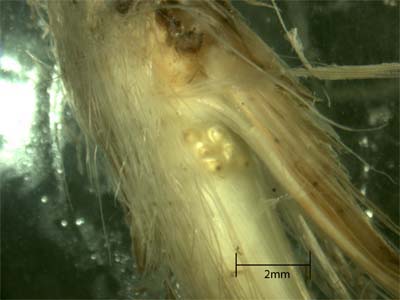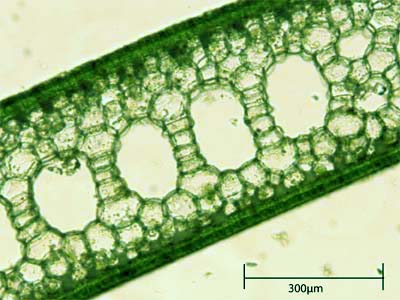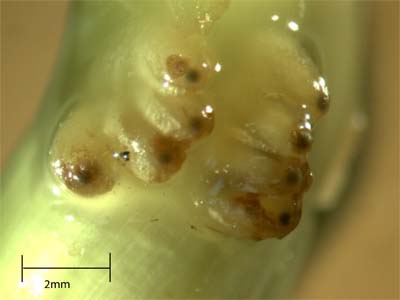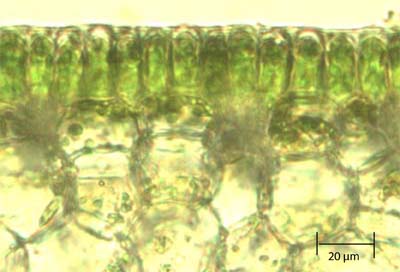
Surf Grass
Morphology
Cross section of stem. P. scouleri
Leaf blade cross section. Large spaces are air lacuna. Right side of blade is the begining of a vascular bundle. Specimen from Cattle Point on San Juan Island, WA. P. scouleri
Top down view of chlororplasts in epidermis of leaf blade. Specimen collected at Cattle Point on San Juan Island, WA. P.scouleri
|
|
Morphology Rhizome and Roots Rhizomes serve the purpose of anchoring, mechanical support, nutrient storage, and regulation and maintenance of vegetative growth. Internodes short, and short roots at internodes (Hooker, 2009). Phyllospadix has two groups of rhizome nodes that are extremely short with numerous root hairs used to attach to hard substrates. Unlike other seagrasses Phyllospadix can firmly attach to rock surfaces in high energy environments. Features that enhance ability to adhere to rocky shore high wave environments include greater hypodermal fiber and root hair development, thickened rhizomes and smaller lacunae (Cooper and McRoy, 1988). Some evidence has shown that adhesive glue is secreted from rhizomes to help roots adhere to hard substrates (Wyllie-Echeverria). "When the roots are several millimeters long they begin to produce, near their tips, a dense, woolly covering of root- hairs, and when a root comes in contact wit any object, - be it the stem of Amphiroa, the rock beneath, or another root, - these rhizoidal hairs spread, as a closely adhering film of whitish fibers, over the surface touched, binding the root to it. The root-hairs assume fantastic shapes in order to conform with the irregularities of the rock (Gibbs, 1902)."
New roots of P. scouleri forming near rhizome.
Stem Stems tens to form at each rhizome node. Erect stems result from sympodial branching of rhizomes (Larkum, 2006). No woody or lignin structures are found in surf grass anatomy. Surf grasses have a flexible stem that can withstand high energy wave environments.
Leaf blade Blades are narrower compared to eel grass species and less complex compared to terrestrial monocots. The interior of the leaf blades consist of specialized parenchymous tissue called aerenchyma. The air spaces within the leaf are called lacunae. These internal air spaces help with flotation and gas exchange (Arber, 1920). Chloroplasts are commonly found in outer epidermal cells of leaf blade.
Lead blade epidermis with chloroplasts. Specimen collected at Cattle Point on San Juan Island, WA. P. scouleri
References Arber A (1920) Water plants. A Study of Aquatic Angiosperms. Cambridge University press, Cambridge. Cooper LW and McRoy CP (1988) Anatomical adaptation to rocky substrates and surf exposure by the seagrass genus Phyllospadix. Aquat Bot 32: 365 – 381 Gibbs, Ralph Erwin. Phyllospadix as a Beach-Builder. The American Naturalist, Vol. 36, No. 422 (Feb., 1902) pp. 101- 109. The University of Chicago Press for The American Society of Naturalists. Hooker, W.J. Phyllospadix. AlgaeBase. May 13, 2009. <http://www.algaebase.org/browse/taxonomy/?id=7300> Larkum, Anthony W.D., Orth, Robert J., Duarte, Carlos M. Seagrasses: Biology, Ecology and Conservation. Springer 2006. p.92 Wyllie-Echeverria, Sandy. Personal Interview. May 13, 2009.
|
 Rhizomes attached to hard substrate at Botanical Beach on Vancouver Island, WA
Rhizomes attached to hard substrate at Botanical Beach on Vancouver Island, WA Rhizomes of P. scouleri with numerous root hairs. In center of picture new roots forming in groups of two. Extremely short roots densely covered with root hairs.
Rhizomes of P. scouleri with numerous root hairs. In center of picture new roots forming in groups of two. Extremely short roots densely covered with root hairs.



